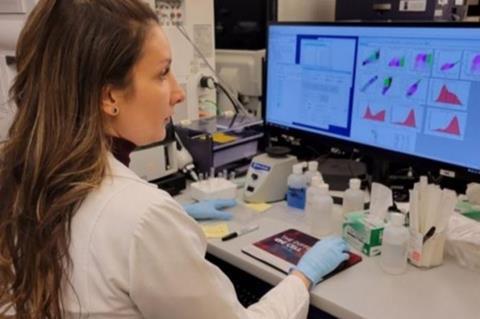An article published in the journal Cell describes a study that enabled a group of researchers to discover how SARS-CoV-2 evades the cytotoxic immune response by identifying a protein called ORF6 that is a key factor in this mechanism.

The cytotoxic immune response involves T-lymphocytes that kill pathogens when they recognize cells bearing a specific antigen while sparing neighboring uninfected cells.
READ MORE: Virus that causes COVID-19 can penetrate blood-retinal-barrier and could damage vision
READ MORE: Specific nasal cells protect against COVID-19 in children
The study was led by Wilfredo Garcia-Beltran and Julie Boucau, research scientists at the Ragon Institute of Massachusetts General Hospital (MGH), Massachusetts Institute of Technology (MIT) and Harvard University in the United States. The first authors of the article are Marcella Cardoso, a Brazilian postdoctoral research fellow at Harvard Medical School (HMS) and MGH, and Jordan Hartmann, also of HMS. Scientists affiliated with institutions in Brazil and Germany also took part.
Evading detection
“We discovered that SARS-CoV-2 is able to evade detection by the immune system by diminishing the vestiges that point to the presence of the virus in cells. In this process, the virus disturbs certain proteins on the surface of infected cells to inhibit interaction between them and T-lymphocytes,” Cardoso explained.
Defense cells known as natural killers (NKs) are fundamental to detect and combat viruses. They are part of the innate immune response, the first barrier against infection. NKG2D, a protein expressed on the surface of NKs, recognizes and kills infected cells (and cancer cells) by targeting stress-induced ligands released by the infection, such as MIC-A and MIC-B. This recognition is essential for contaminated cells to be removed from the organism.
Viral proliferation
Systematic analysis of the proteins in SARS-CoV-2 led to the finding that ORF6 – unique to and conserved among mammalian sarbecoviruses (the subgenus of Coronaviridae to which the virus that causes COVID-19 belongs) – participates actively in the removal of these important signalers of infected cells, facilitating viral proliferation in the host organism.
Confirming this evasion mechanism, when MIC-A and MIC-B receptors were protected with 7C6, an antibody used as a “shield”, NKs were far more successful in finding and destroying infected cells.
The co-authors of the article include four other Brazilians: Maria Cecília Ramiro, a PhD candidate at the State University of Campinas’s School of Medical Sciences (FCM-UNICAMP); and Fernanda Orsi, Lício Velloso and Erich de Paula, professors at FCM-UNICAMP.
Pandemic projects
According to De Paula, UNICAMP’s participation was linked to projects funded by FAPESP during the pandemic.
“Our group collaborated with the discussion of strategies and the sharing of a clinical cohort used to validate the data,” he said.
De Paula was principal investigator for the project “Evaluation of the mechanisms of hemostatic activation in COVID-19 and their modulation by bradykinin inhibitors”.
Velloso was principal investigator for the project “Clinical trial of bradykinin inhibition in hospitalized adults with severe COVID-19”, from which some of the clinical data and samples were obtained.
Elimination of proteins
“Studies of the immune response in severe COVID-19 patients showed that this elimination of proteins also occurred in these cases. Data collected from patients during hospitalization were key to this cross-border research project, demonstrating the importance of the role of collaborative research with hospitals to contain pandemics in real time,” Cardoso said.
Samples collected at UNICAMP’s general and teaching hospital (Hospital de Clínicas) displayed greater diversity of clinical outcomes in response to the action of different strains of the virus. “In parallel, we conducted in vitro experiments in which lung tissue cells were infected with the live virus,” Cardoso said.
Monoclonal antibodies
In light of recent preclinical oncological trials showing that monoclonal antibody 7C6 can prevent elimination of MIC-A and -B (which stimulate NKs and T-cells), the researchers decided to see if it would also be effective to curtail evasion of the immune system by the virus.
“We expected this approach to not only stimulate elimination of infected cells but also increase co-stimulation of CD8+ T cells [lymphocytes of the adaptive immune system, often called cytotoxic T lymphocytes, or CTLs], thus activating both the innate and adaptive immune systems,” Cardoso explained. A series of experiments and in vitro assays were conducted to test the hypotheses.
“Knowing how SARS-CoV-2 and other coronaviruses affect these proteins and how this influences the immune response helps us understand better how they interact with the body. It also helps identify possible targets for novel treatments to strengthen the immune system and combat viral infections,” Cardoso said.
New research fronts
The results open up research fronts in the field of host-directed antiviral therapies since the discovery of the role played by the antibody 7C6 in boosting the elimination of cells infected by SARS-CoV-2 also points to possible innovative therapeutic strategies.
“Based on these results, it will be possible to conduct in vivo trials using transgenic animal models with the aim of evaluating the clinical applicability of the strategy. Further stages of the research are still needed, but the results are highly promising,” Cardoso said.
Topics
- COVID-19
- cytotoxic immune response
- Erich de Paula
- Fernanda Orsi
- Harvard University
- Hospital de Clínicas
- Immunology
- Jordan Hartmann
- Julie Boucau
- Lício Velloso
- Marcella Cardoso
- Maria Cecília Ramiro
- Massachusetts General Hospital
- Massachusetts Institute of Technology
- NKG2D
- One Health
- ORF6
- Research News
- SARS-CoV-2
- The Americas
- T-lymphocytes
- UK & Rest of Europe
- USA & Canada
- Virology
- Wilfredo Garcia-Beltran







No comments yet